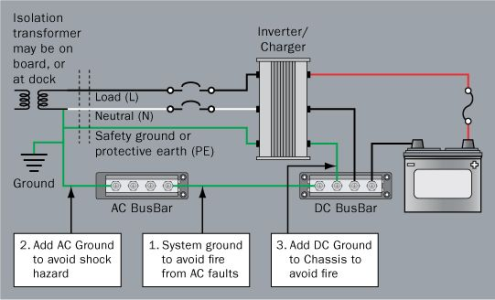Janinna2
New member
I'm seeing conflicting information about grounding inverters and RCD connections to ground on boats.
I appreciate the U.S system and advice is different to Europe so I am looking for U.K advice.
Renogy in their manual for a 3000w (and 2000w inverter) say that if you use an RCD on the outgoing side of their inverter (so the 240v AC coming out) then the neutral and ground should be joined.
When I asked an advisor if this was correct they said we don't advise using an RCD on the output. I pointed out that comment was incorrect given their instruction manual.
So now I am waiting for a more detailed response. But I have seen elsewhere that others have had conflicting errors in Renogy manuals.
So, I have a couple of fairly straightforward questions
Current practice for using an inverter and RCD in the UK on a GRP boat.
1. Should the ground of the metal casing of an inverter have a ground cable connecting direct to the Anode?
2. If an RCD is fitted on the 240vac outlet of the inverter should the earth have a connection back to the anode?
3. Should the neutral also be linked back to the Anode?
4. If an additional RCD were to be used that comes from the shore power cable to the inverter input (the Renogy 3000w inverter has an automatic transfer switch to accept shore power) should the earth bus bar in that RCD have a ground to the anode.
And all the questions above need to consider that the negative from Batteries on board also connect to the anode as does the engine block.
Basically I am looking for clear information on correct method of giving fault protection to AC and DC where they share a common ground at the anode?
I appreciate the U.S system and advice is different to Europe so I am looking for U.K advice.
Renogy in their manual for a 3000w (and 2000w inverter) say that if you use an RCD on the outgoing side of their inverter (so the 240v AC coming out) then the neutral and ground should be joined.
When I asked an advisor if this was correct they said we don't advise using an RCD on the output. I pointed out that comment was incorrect given their instruction manual.
So now I am waiting for a more detailed response. But I have seen elsewhere that others have had conflicting errors in Renogy manuals.
So, I have a couple of fairly straightforward questions
Current practice for using an inverter and RCD in the UK on a GRP boat.
1. Should the ground of the metal casing of an inverter have a ground cable connecting direct to the Anode?
2. If an RCD is fitted on the 240vac outlet of the inverter should the earth have a connection back to the anode?
3. Should the neutral also be linked back to the Anode?
4. If an additional RCD were to be used that comes from the shore power cable to the inverter input (the Renogy 3000w inverter has an automatic transfer switch to accept shore power) should the earth bus bar in that RCD have a ground to the anode.
And all the questions above need to consider that the negative from Batteries on board also connect to the anode as does the engine block.
Basically I am looking for clear information on correct method of giving fault protection to AC and DC where they share a common ground at the anode?

